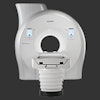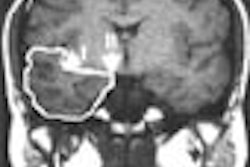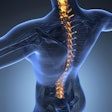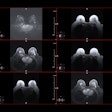CHICAGO – The presence of white matter hyperintensity on T2-weighted MRI and the risk of clinical stroke are directly related, independent of traditional risk factors, said Dr. Norman Beauchamp in a presentation Monday at RSNA 2001. And by combining white-matter grade with other known risk factors, researchers have defined a subset of particularly high-risk individuals.
Regions of periventricular and subcortical T2-weighted white matter hyperintensity or leukoariosis are frequently identifiable in patients aged sixty-five and older, Beauchamp noted. So he and fellow researchers at Johns Hopkins Medical School researchers sought to evaluate the relationship between that hyperintensity and stroke risk. Although the etiology is incompletely defined, the most widely accepted mechanism is ischemic. Previous to the Johns Hopkins research, the role of this marker of cerebrovascular disease as a predictor of future stroke risk remained unknown.
To examine the possible relationship, Beauchamp and his colleagues turned to the Cardiovascular Health Study, a large-scale epidemiological evaluation of cardiovascular and cerebrovascular disease. In this study, 3,295 participants with no contraindications underwent a standard MR exam including axial spin echo T1-weighted, spin-density, and T2-weighted scans.
The researchers read the images blinded to all clinical information about the patients, assigning the signal changes of each individual on a semiquantitative, ten-point scale for white-matter grade (WMG). They estimated WMG as the total extent of periventricular and subcortical white matter signal abnormality on spin-density-weighted axial images, ranging from none or barely detectable (grades 0 and 1, respectively) to almost entirely white matter (grade 9).
After five years, 159 of the 3,295 participants in the analysis (or 12.1 per thousand person-years) had suffered strokes. The researchers found a stepwise increase in incidence when evaluating white matter grade as a continuous variable. The incidence and relative risk of stroke increased, by level of WMG, 5.9 per 1,000 years for grades 0 and 1 to 28.1 per 1,000 years for WMG greater than 5.
This relationship was maintained even when the researchers adjusted for known stroke risk factors placed in the Cox Regression Model (with a hazard ratio of 3.3 and WMG greater than five versus WMG 0 and 1). With left ventricular hypertrophy identified by ECG, internal carotid wall thickness, and creatine level greater than 1.25 mg/dl in the model, the hazard ratio for WMG greater than five increased to 2.7 relative to WMG 0 and 1.
"Perhaps using these T2 high white-matter hyperintensities [can] better determine which patients require more intensive preventive stroke therapy," Beauchamp concluded. "Also, this is a clinically feasible measure. We trained our technologists to do it and they can do it within two minutes in the clinic."
By Leslie Farnsworth
AuntMinnie.com contributing writer
November 26, 2001
For the rest of our coverage of the 2001 RSNA meeting, go to our RADCast@RSNA 2001.
Copyright © 2001 AuntMinnie.com



















